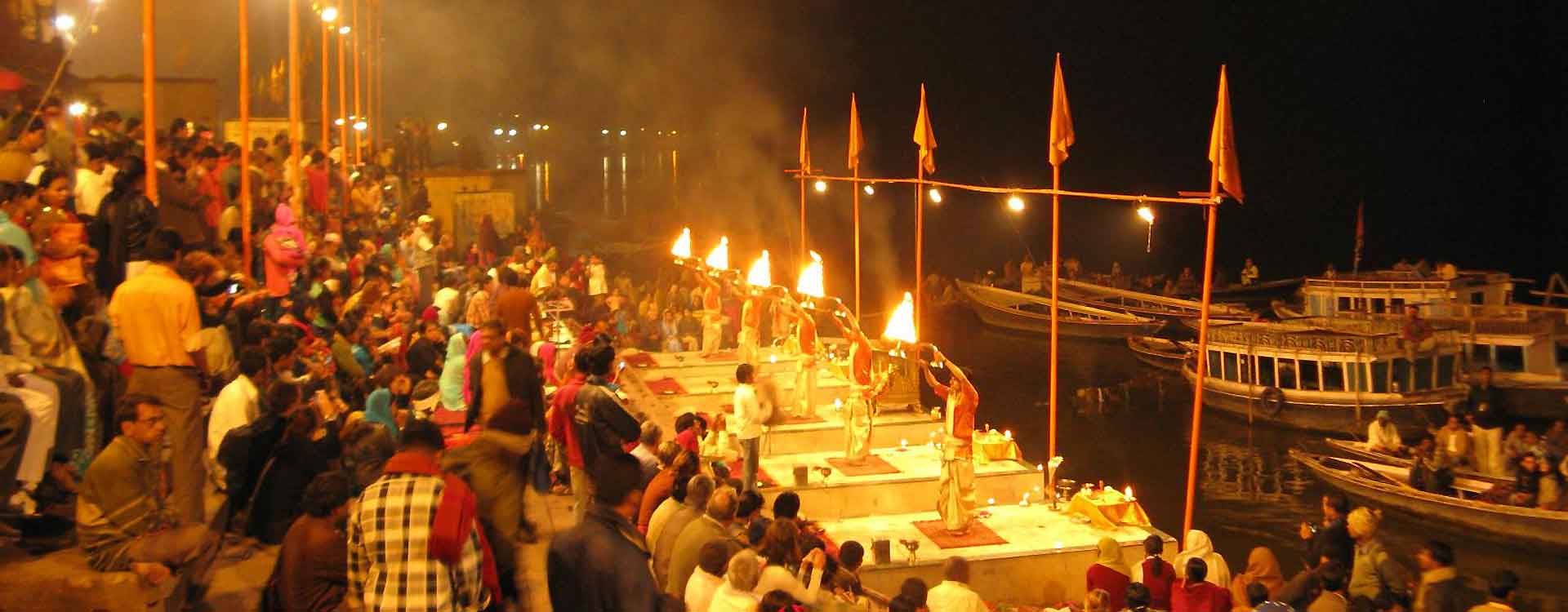Varanasi or Banaras, mentioned in the scriptures as Kashi, is less of a city and more of a dreamy experience. It is a paragon of Indian culture, philosophy, traditions and spiritual ethos since times immemorial. It is among the Sapta Puries, meaning seven sacred cities of Ancient India. The city is located on the bank of River Ganga which has two tributaries in the city: Varuna and Assi hence the name Varanasi. The combination of Kashi – the holy city, Ganga- the sacred river and Shiva- the supreme God, makes Varanasi an immortal destination.
Today, Varanasi remains the hub of cultural and holy activities. In the field of learning, especially of Religion, Philosophy, Yoga, Ayurveda, Astrology, Dance and Music, the city is certainly unparalleled. The Banarasi Silk Sarees and Brocades are known worldwide for its elegance. Varanasi is full of surprises abounding every corner; the more one explores it, the more one falls in love with it!
History
The land of Varanasi (Kashi) has been the ultimate pilgrimage spot for Hindus for ages. Often referred to as Benares, Varanasi is the oldest living city in the world. These few lines by Mark Twain say it all: "Benaras is older than history, older than tradition, older even than legend and looks twice as old as all of them put together". Hindus believe that one who is graced to die on the land of Varanasi would attain salvation and freedom from the cycle of birth and re-birth. Abode of Lord Shiva and Parvati, the origins of Varanasi are yet unknown. Ganges in Varanasi is believed to have the power to wash away the sins of mortals.
Ganges is said to have its origins in the tresses of Lord Shiva and in Varanasi, it expands to the mighty river that we know of. The city is a center of learning and civilization for over 3000 years. With Sarnath, the place where Buddha preached his first sermon after enlightenment, just 10 km away, Varanasi has been a symbol of Hindu renaissance. Knowledge, philosophy, culture, devotion to Gods, Indian arts and crafts have all flourished here for centuries. Also a pilgrimage place for Jains, Varanasi is believed to be the birthplace of Parsvanath, the twenty-third Tirthankar.
Vaishnavism and Shaivism have co-existed in Varanasi harmoniously. With a number of temples, Mrs. Annie Besant chose Varanasi as the home for her 'Theosophical Society' and Pandit Madan Mohan Malviya, to institute 'Benares Hindu University, the biggest University in Asia. Ayurveda is said to be originated at Varanasi and is believed to be the basis of modern medical sciences such as Plastic surgery, Cataract and Calculus operations. Maharshi Patanjali, the preceptor of Ayurveda and Yoga, was also affiliated with Varanasi, the holy city. Varanasi is also famous for its trade and commerce, especially for the finest silks and gold and silver brocades, since the early days.
Varanasi has also been a great center of learning for ages. Varanasi is associated with promotion of spiritualism, mysticism, Sanskrit, yoga and Hindi language and honored authors such as the ever-famous novelist Prem Chand and Tulsi Das, the famous saint-poet who wrote Ram Charit Manas. Aptly called as the cultural capital of India, Varanasi has provided the right platform for all cultural activities to flourish. Many exponents of dance and music have come from Varanasi. Ravi Shankar, the internationally renowned Sitar maestro and Ustad Bismillah Khan, (the famous Shehnai player) are all sons of the blessed city or have lived here for major part of their lives.
Places to Visit
Varanasi Ghat
Varanasi or Kashi is older than traditions. Varanasi presents a unique combination of physical, metaphysical and supernatural elements. According to the Hindu mythology, Varanasi liberates soul from human body to the ultimate. It is the Ganga Ghats of Varanasi that complement the concept of divinity. Ghats of Ganga are perhaps the holiest spots of Varanasi. The Ganga Ghats at Varanasi are full of pilgrims who flock to the place to take a dip in the holy Ganges, which is believed to absolve one from all sins.
There are number of temples on the bank of the Ganga river in Varanasi. It is believed that people are cleansed physically, mentally and spiritually at Ganga Ghats. It is at the Ganga Ghats where we see life and death together. For thousands of years people have been thronging these Ghats to offer their morning prayers to the rising sun. There are more than 100 ghats along side Ganga in Varanasi. Some of the prominent and popular Ghats at Varanasi are the Dasaswamedh Ghat, Manikarnika Ghat, Harischandra Ghat, Kabir Ghat and Assi Ghat.
River Ganga
River Ganga or the Ganges is a major river of the Indian subcontinent, associated in myth and reality with the land and people of India as well as neighboring countries like Bangladesh. In Hinduism, the river Ganga is personified as Goddess and holds an important place in the Hindu religion. In Hindu mythology, it is believed that bathing in the river Ganga causes the remission of sins and facilitates the attainment of salvation or nirvana. This deep-rooted truth is proved by the fact that people travel from distant places to immerse the ashes of their kin in the waters of the Ganga at Varanasi or other places located on the banks of this holy river. Some of these sacred places, located on the Ganga, are Varanasi, Haridwar and Prayag (Allahabad).
The first Prime Minister of India, Pandit Jawahar Lal Nehru, aptly summarized the importance of River Ganga in the hearts of the Indians, in general, and Hindus, in particular.
"The Ganga, especially, is the river of India, beloved of her people, round which are intertwined her memories, her hopes and fears, her songs of triumph, her victories and her defeats. She has been a symbol of India's age-long cultureand civilization, ever changing, ever flowing, and yet ever the same Ganga".
Jantar Mantar
Jantar Mantar is an observatory, built by Jai Singh, the Maharaja of Jaipur in the year 1737. Jai Singh was a great admirer of science and technology and he was particularly passionate about astronomy. Before the commencement of construction (of observatories) he sent scholars abroad to study the foreign observatories. The emissaries returned with many manuals on astronomy. The Jantar Mantar at Varanasi was built in line with Delhi, Mathura, Ujjain and Jaipur observatories.
The Jantar Mantar was built to measure the local time, the Sun's declination, altitude, the declination of stars, planets and to determine eclipses The Jantar Mantar at Varanasi has several masonry instruments to record the motion, speed and properties starts and planets and study astronomy that are accurate and can still be used efficiently today. The Jantar Mantar incorporates multiple structures of unique form, each with a specialized function for astronomical measurement.
These structures with their striking combinations of geometric forms have captivated the attention of architects, artists, and art historians. Originally, there were many yantras (instruments). Some of the important ones are the Krantivritta Yantra, Digansha Yantra, Samrat Yantra, Prakash Yantra, Ram Yantra, Disha Yantra and Dhruva Yantra.
Sarnath Museum
Sarnath has yielded a rich collection of sculptures, artifacts and edifices comprising numerous Buddha and Bodhisattva images and other ancient remains. To house all the findings and excavations at Sarnath, the Archaeological Survey of India established a site Museum at Sarnath. Finest specimens of Buddhist art and other important remains have been housed at the museum.
While the single most famous exhibit of this museum is the lion capital, the Sarnath museum has a small but awe-inspiring collection of Buddhist artifacts. Among the things to see is a beautiful sculpture of the Lord Buddha from the fifth century. The Buddha sits cross-legged, with eyes downcast in deep meditation, and a halo around his head. Also worth exploring are several beautiful figures of the bodhisattvas.
Of other Buddhist remains there is an impressive and amazingly beautiful, life-size standing Bodhisattva and a delicate image of the Bodhisattva with a lotus and yet another bronze sculpture showing the Bodhisattva with multiple arms. The museum at Sarnath also houses an excellent collection of figures and sculptures from the Mauryan, the Kushana and the Gupta periods. Prominent of them is the earliest Buddha image found at Sarnath and many images of Hindu Gods dating from the 9th to 12th centuries.
The main attraction of the Sarnath Archaeological Museum is the superb Ashokan Pillar. It has four back-to-back lions, which has been adopted as the National symbol of India. Below this are representations of a lion, an elephant, horse and the bull.
Bharat Mata Temple
The Bharat Mata temple at Varanasi is the only temple dedicated to Mother India. It is located in the Mahatma Gandhi Kashi Vidyapeeth campus. The Bharat Mata temple was built by Babu Shiv Prasad Gupt and inaugurated by Mahatma Gandhi in 1936. The statute of Bharat Mata is built in marble and is a model of undivided India, depicting the mountains, plains and oceans. The most peculiar thing about the Bharat Mata Temple is that instead of the customary gods and goddesses, it houses a relief map of India, carved out of marble.
Sankat Mochan Temple
Sankat Mochan temple is one of the sacred temples of Varanasi. It is located in the southern part of Varanasi, near the Banaras Hindu University. It is dedicated to the Hindu God, Hanuman. The word "Sankat Mochan" means one who helps in removing sufferings i. e. Lord Hanuman. Tulsidas, the author of the famous Hindu epic Ramacharitamanasa, founded the Sankat Mochan temple. According to Hindu mythology, one who visits the Sankat Mochan temple regularly, his wishes get fulfilled.
Every Tuesday and Saturday, thousands of devotees queue up in front of the Sankat Mochan temple to offer prayers to Lord Hanuman. According to Vedic Astrology, Hanuman protects human beings from the anger of planet Saturn and those who have ill placed Saturn in their horoscope visit the Sankat Mochan temple to get remedy. People put "Sindoor" on the statue and offer "laddoos" to Lord Hanuman. The "Sindoor", from the statue of Lord Hanuman is put on the foreheads of devotees.
Vishwanath Temple
The Kashi Vishwanath temple is located in the heart of the cultural capital of India, Varanasi. It stands on the western bank of India's holiest river Ganges. The Kashi Vishwanath temple is the center of faith for millions of Hindus. The Jyotirlinga of Shiva, Vishweshwara or Vishwanatha, is enshrined in the Kashi Vishwanath temple, considered as one of the holiest temples of India. In Hindu religion it is believed that a simple glimpse of the Jyotirlinga is a soul-cleansing experience that transforms life and puts it on the path of knowledge and Bhakti (devotion). A single darshan of Vishweshwara Jyotirlinga is considered to merit more than the darshan of other jyotirlingas, scattered in various parts of India. The Kashi Vishwanath Temple has been a living picture of the timeless cultural traditions and highest spiritual values.
The Kashi Vishwanath Temple attracts Hindu devotees and other visitors not only from India but also the world over. Lord Vishwanath is considered the supreme repository of the spiritual truth and strengthens the bonds of universal brotherhood. Late Maharani Ahilya Bai Holkar of Indore built the temple in the present shape, way back in 1780. In the year 1785, a Naubatkhana was built up in front of the Temple at the instance of Governor General, Warren Hastings. In 1839, two domes of the Temple were covered by gold, donated by Maharaja Ranjeet Singh, the ruler of Punjab. The management of the Kashi Vishwanath temple rests with a trust.
The Vishwanath temple opens daily at 2.30 A.M. for Mangala Aarti and between 3 to 4 A.M. ticket holders are permitted to join. The timing of general Darshan is from 4 to 11 A.M. The timing for midday Bhog Aarti is from11.30 to 12 A.M. Between 12 noon to 7 P.M., general devotees are free to have Darshan. From 7 to 8.30 P.M. the Sapta Rishi Aarati is held after which Darshan is possible again till 9 P.M. At 9 P.M. the Shringar/Bhog Aarati starts and after that Darshan is possible only from outside. Shayana Aarti starts at 10.30 P.M. and the temple closes at 11 P.M. Most of the offerings at the Kashi Vishwanath temple are given to poor.
How To Reach Varanasi
Varanasi is the cultural capital of India and the melting pot of Indian civilization. Varanasi or Benaras has a well-developed transport network and is well connected to all the major Indian cities and states by air, road and rail.
By Air
Varanasi is well connected and accessible to major Indian cities and tourist spots. There are daily domestic flights to and from Varanasi to several cities in India. Apart from the state owned Indian Airlines, there are many private air taxi operators that offer their services from Varanasi to other Indian cities. In fact, the daily flights on Delhi-Agra-Khajuraho-Varanasi route are quite popular among the tourists.
By Rail
Since Varanasi lies in the heartland of the North Indian plains, it is well connected to Delhi, Kolkata, Mumbai and other parts of India. There are two railway stations in Varanasi, the Kashi Junction and the Varanasi Junction (also known as Varanasi Cantonment). Rajdhani Express from Delhi or from Calcutta passes through Varanasi too. One can also catch trains from Mughalsarai, just 10 km south of Varanasi.
By Road
Situated in the flat Ganga plains, Varanasi has a good network of roads. frequent public and private buses and road transport to all the major towns of Uttar Pradesh and nearby areas.
Best Time to Visit
Peak Season - (November to February)
The best time to visit Varanasi is during the winter months (November to February). Although it gets fairly cold during the winters, this is the best time when you can explore the holy city without getting tired. The average low temperature is around 5°C.
Off Season
You can plan a spiritual journey to Varanasi any time of the year but remember that summers in Varanasi last long (from April to October) and the temperature generally is on the higher side of 30°C going up to 45°C in peak summers. If you go during this time, don't forget to carry your sunscreen.






